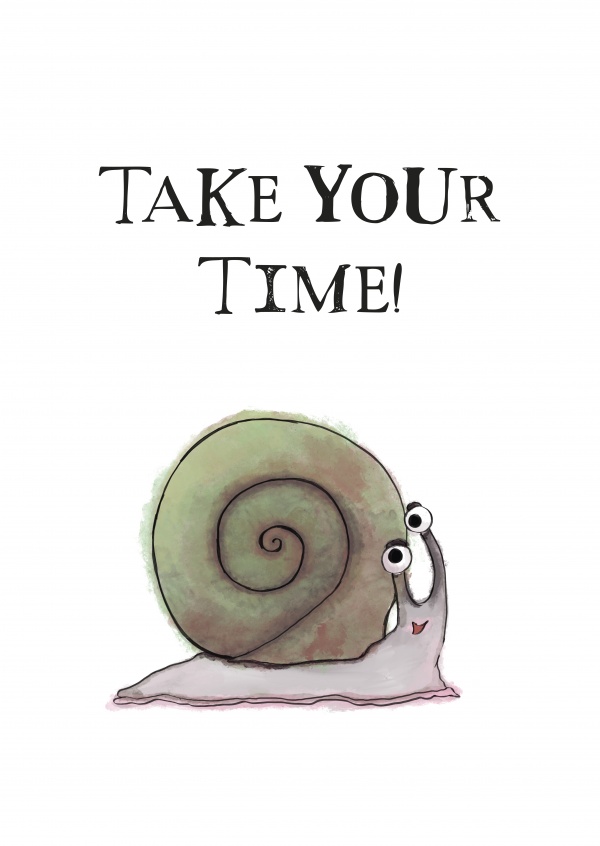
In our fast-paced world, rushing often leads to mistakes and regret. Taking your time offers numerous benefits, including improved mental clarity and better performance. By slowing down, you can focus more on the task at hand, leading to higher quality work.
This approach helps in making more informed decisions, ultimately saving time and resources in the long run. Embracing a slower pace can also enhance creativity and problem-solving abilities. It creates a more balanced and fulfilling life. Prioritizing tasks and setting realistic deadlines are crucial steps in managing your time effectively.
Introduction To Mindful Living
In our fast-paced world, stress is a constant companion. We rush through our days, missing the beauty around us. Mindful living offers a way to slow down and appreciate life. It encourages us to be present in each moment. This practice can bring peace and joy to our lives.
What Is Mindfulness?
Mindfulness means paying full attention to the present moment. It involves being aware of your thoughts, feelings, and surroundings. This awareness helps you respond calmly to life’s challenges. Mindfulness is not about emptying your mind. It’s about noticing what’s happening without judgment.
Benefits Of Mindful Living
Mindful living can improve your mental and physical health. Here are some key benefits:
- Reduces Stress: Mindfulness helps lower stress levels.
- Boosts Focus: Being present improves concentration and focus.
- Enhances Emotional Health: It promotes a positive mindset.
- Improves Relationships: Mindfulness fosters better communication and empathy.
- Better Sleep: It can lead to more restful sleep.
Incorporate these simple practices into your daily routine:
- Take deep breaths and observe your surroundings.
- Practice gratitude by noting things you appreciate.
- Engage in activities like yoga or meditation.
Start your journey towards a more mindful life today.

Practicing Mindfulness Daily
Practicing mindfulness each day helps you stay present. It reduces stress and increases focus. Let’s explore how to integrate mindfulness into your daily routines.
Morning Routines
Start your day with a mindful morning routine. This sets a positive tone for the rest of the day. Try these steps:
- Wake Up Early: Give yourself extra time to start the day calmly.
- Stretch: Gentle stretching helps wake up your body.
- Mindful Breathing: Spend five minutes focusing on your breath.
- Gratitude Journal: Write down three things you’re thankful for.
- Healthy Breakfast: Eat a nutritious meal mindfully.
Mindful Eating
Mindful eating means paying full attention to your food. It helps you enjoy your meals and makes healthier choices. Follow these tips:
- Eat Slowly: Chew each bite thoroughly.
- Avoid Distractions: Turn off the TV and put away your phone.
- Notice Flavors: Savor each flavor and texture.
- Listen to Your Body: Stop eating when you feel full.
- Gratitude: Be thankful for your food.
Practicing mindfulness daily isn’t difficult. It just takes a bit of time and effort. Start with these small steps and build from there.
Mindfulness In Work
Being mindful at work improves productivity and reduces stress. It helps you stay focused and more engaged in tasks. Practicing mindfulness can transform your work experience positively.
Staying Present
Staying present at work means focusing on the current task. Avoid distractions like emails and social media. Use techniques like deep breathing or short meditations. These can help you bring your attention back to the present moment.
Avoid multitasking. Multitasking reduces efficiency. Instead, complete one task at a time. This helps in producing better quality work.
Managing Stress
Mindfulness helps in managing stress effectively. Take short breaks during work hours. Stretch, walk, or simply breathe deeply. This helps in reducing tension.
Keep a stress journal. Write down what triggers stress. Identify patterns and find solutions to avoid these triggers. Practicing gratitude also helps. Write down three things you are grateful for each day.
| Mindfulness Technique | Benefits |
|---|---|
| Deep Breathing | Reduces stress and anxiety |
| Short Meditations | Increases focus and concentration |
| Gratitude Journal | Improves mood and outlook |
Incorporate these mindfulness techniques into your work routine. Experience a more balanced and productive work life.
Mindful Relationships
Mindful relationships help us connect deeply with others. They require presence and attention. This means being fully engaged and aware. It means understanding our emotions and those of others. Let’s explore two key aspects: active listening and emotional awareness.
Active Listening
Active listening is more than just hearing words. It means truly understanding the speaker. Here are some ways to practice active listening:
- Maintain eye contact: Show interest and respect.
- Avoid distractions: Put away phones and gadgets.
- Nod and smile: These actions show you are engaged.
- Ask questions: Clarify points to show you are listening.
Active listening builds trust and strengthens relationships. It shows you value the other person’s thoughts and feelings.
Emotional Awareness
Emotional awareness involves recognizing and understanding feelings. This includes both your own and others’. Here are some tips:
- Identify your emotions: Name what you feel.
- Understand triggers: Know what causes your emotions.
- Empathize with others: Try to feel what they feel.
- Express emotions healthily: Share your feelings calmly.
Being emotionally aware helps in responding appropriately. It fosters deeper connections and mutual respect.
| Practice | Benefit |
|---|---|
| Active Listening | Builds trust and engagement |
| Emotional Awareness | Fosters deeper connections |
Mindful relationships thrive on active listening and emotional awareness. These practices enrich our connections with others. They make our interactions more meaningful and fulfilling.
Mindfulness And Physical Health
Mindfulness is a powerful tool for improving physical health. It helps you stay present and aware. This awareness leads to better decisions about your body. Let’s explore some ways to integrate mindfulness into your physical health routine.
Mindful Exercise
Mindful exercise is about paying attention to your body. Feel each movement and muscle. Notice your breathing and heartbeat. This practice helps you stay focused and reduces the risk of injury.
- Yoga: Focus on your breath and poses. Feel the stretch in your muscles.
- Walking: Pay attention to each step. Notice the ground beneath your feet.
- Strength Training: Concentrate on your form. Feel each muscle working.
Mindful exercise can boost your physical health. It makes workouts more enjoyable and effective.
Breathing Techniques
Breathing techniques are a key part of mindfulness. They help you stay calm and focused. Proper breathing supports your body’s functions and reduces stress.
| Technique | How to Practice |
|---|---|
| Deep Breathing | Inhale deeply through your nose. Exhale slowly through your mouth. |
| Box Breathing | Inhale for four counts. Hold for four. Exhale for four. Hold for four. |
| Alternate Nostril Breathing | Close one nostril and inhale. Switch nostrils and exhale. |
Practice these techniques daily. They can improve your physical health and mental clarity. Start with a few minutes each day. Gradually increase the time as you become more comfortable.

Overcoming Challenges
Everyone faces challenges. Taking your time can help. This section will guide you through overcoming obstacles.
Dealing With Distractions
Distractions can interrupt your focus. Identifying them is the first step. Keep a list of common distractions.
- Social media notifications
- Phone calls and messages
- Background noise
Once you know your distractions, manage them. Use tools like Do Not Disturb mode on your phone. Set specific times to check social media.
Here’s a simple table to manage distractions:
| Distraction | Management Tool |
|---|---|
| Social Media | Schedule checks |
| Phone Calls | Do Not Disturb mode |
| Background Noise | Noise-cancelling headphones |
Building Consistency
Consistency is key to overcoming challenges. Start small. Set a daily goal. Use a planner to track progress.
Here are steps to build consistency:
- Set clear goals
- Break tasks into smaller steps
- Track your progress
Celebrate small wins. This keeps you motivated. Over time, your small steps add up. You will see big progress.
Mindfulness And Technology
In today’s digital age, technology is everywhere. It impacts our minds deeply. To stay healthy, practicing mindfulness is crucial. This means being aware of our tech use. Let’s explore ways to balance mindfulness with technology.
Digital Detox
A digital detox means taking a break from screens. This helps to reset the mind. Spending too much time on devices can be tiring. A break can boost focus and creativity.
- Turn off notifications.
- Set screen-free zones.
- Have tech-free hours each day.
Doing these things can make you feel more relaxed. Your mind will thank you!
Mindful Social Media Use
Social media can be a double-edged sword. It connects us but can also stress us. Mindful social media use is key. This means being aware of how it affects your mood.
- Limit your time on social apps.
- Unfollow accounts that make you feel bad.
- Engage in positive interactions.
Follow these tips to make social media a happier place. Your mental health will improve.
| Tips | Benefits |
|---|---|
| Turn off notifications | Reduces stress |
| Set screen-free zones | Improves focus |
| Have tech-free hours | Boosts creativity |

Creating A Mindful Environment
A mindful environment helps reduce stress and increase happiness. It encourages focus and peace. Creating such an environment means being intentional about your surroundings. Let’s explore some simple ways to make your space more mindful.
Decluttering Spaces
Clutter can overwhelm and distract. Start by organizing your home. Keep only what you need and love. Use shelves and boxes to store items neatly. Label containers for easy access. A clean space clears your mind.
Here are some quick tips for decluttering:
- Sort items into keep, donate, and discard piles.
- Assign a place for everything.
- Use storage solutions like baskets and bins.
- Regularly review and remove unnecessary items.
Incorporating Nature
Nature calms the mind and body. Bringing natural elements indoors enhances a mindful environment. Plants add beauty and improve air quality. Choose low-maintenance plants like succulents or ferns.
Consider these ideas to incorporate nature into your space:
- Place potted plants on shelves or windowsills.
- Use natural materials like wood and stone in decor.
- Open windows to let in fresh air and sunlight.
- Add water features like small fountains for soothing sounds.
A touch of nature makes any space feel serene and inviting.
Frequently Asked Questions
What Does “please Take Your Time” Mean?
“Please Take Your Time” means don’t rush. It’s about allowing yourself the necessary time to complete a task properly.
Why Is Taking Your Time Important?
Taking your time is important for reducing stress and ensuring quality work. It allows you to think clearly and make better decisions.
How Can Taking Your Time Improve Productivity?
Taking your time can improve productivity by minimizing mistakes and rework. It helps you focus and complete tasks more efficiently.
What Are The Benefits Of Not Rushing?
Not rushing helps maintain mental well-being and enhances creativity. It also improves accuracy and reduces the likelihood of errors.
Conclusion
Taking your time leads to better decisions and reduced stress. Embrace patience for improved mental well-being and productivity. Prioritize quality over speed in every task. By slowing down, you’ll achieve more meaningful results. Remember, life is a marathon, not a sprint.







